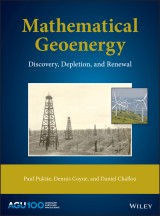Details

Mathematical Geoenergy
Discovery, Depletion, and RenewalGeophysical Monograph Series, Band 241 1. Aufl.
|
169,99 € |
|
| Verlag: | Wiley |
| Format: | |
| Veröffentl.: | 28.11.2018 |
| ISBN/EAN: | 9781119434306 |
| Sprache: | englisch |
| Anzahl Seiten: | 384 |
DRM-geschütztes eBook, Sie benötigen z.B. Adobe Digital Editions und eine Adobe ID zum Lesen.
Beschreibungen
<p><b>A rigorous mathematical problem-solving framework for analyzing the Earth’s energy resources</b></p> <p>GeoEnergy encompasses the range of energy technologies and sources that interact with the geological subsurface. Fossil fuel availability studies have historically lacked concise modeling, tending instead toward heuristics and overly-complex processes. <i>Mathematical GeoEnergy:</i> <i>Oil Discovery, Depletion and Renewal</i> details leading-edge research based on a mathematically-oriented approach to geoenergy analysis.</p> <p>Volume highlights include:</p> <ul> <li>Applies a formal mathematical framework to oil discovery, depletion, and analysis</li> <li>Employs first-order applied physics modeling, decreasing computational resource requirements</li> <li>Illustrates model interpolation and extrapolation to fill out missing or indeterminate data</li> <li>Covers both stochastic and deterministic mathematical processes for historical analysis and prediction</li> <li>Emphasizes the importance of up-to-date data, accessed through the companion website</li> <li>Demonstrates the advantages of mathematical modeling over conventional heuristic and empirical approaches</li> <li>Accurately analyzes the past and predicts the future of geoenergy depletion and renewal using models derived from observed production data</li> </ul> <p>Intuitive mathematical models and readily available algorithms make <i>Mathematical GeoEnergy:</i> <i>Oil Discovery, Depletion and Renewal </i>an insightful and invaluable resource for scientists and engineers using robust statistical and analytical tools applicable to oil discovery, reservoir sizing, dispersion, production models, reserve growth, and more.</p>
<p>Preface vii</p> <p>1. Introduction to Mathematical Geoenergy 1</p> <p>2. Stochastic Modeling 5</p> <p><b>Part I: Depletion</b></p> <p>3. Fossil Fuel Depletion Modeling 13</p> <p>4. Discovering Oil Reserves 17</p> <p>5. Analysis of Production and the Shock Model .41</p> <p>6. Characterizing Discovery, Production, and Reserve Growth 61</p> <p>7. Comparing the Oil Production Model to Data 85</p> <p>8. Alternative Characterization and Models 109</p> <p>9. Models for Future Production 131</p> <p><b>Part II: Renewal</b></p> <p>10. Energy Transition: Applying Probabilities and Physics 157</p> <p>11. Wind Energy 167</p> <p>12. Wave Energy 179</p> <p>13. Geophysical Energy 205</p> <p>14. Thermal Energy: Diffusion and Heat Content 213</p> <p>15. Latent Energy: Hydrological Cycle 225</p> <p>16. Gravitational Potential Energy: Terrain and Topography 233</p> <p>17. Solar Energy: Thermodynamic Balance 267</p> <p>18. Geoenergy Conversion .273</p> <p>19. Dissipative Energy: Resilience, Durability, and Reliability 291</p> <p>20. Dispersed Energy: Particulates and Transport in the Environment 305</p> <p>21. Electromagnetic Energy: Noise and Uncertainty .319</p> <p>Epilogue 327</p> <p>Appendix A: The Effect and Role of Feedback 329</p> <p>Appendix B: Using Pipes and Flow to Compute Convolution 331</p> <p>Appendix C: Dispersion Analogies 333</p> <p>Appendix D: Regional Oil Discovery and Production Profiles 341</p> <p>Appendix E: Compartment Models 343</p> <p>Appendix F: US Reserve Growth 345</p> <p>Appendix G: Table of Acronyms 349</p> <p>Index 351a</p>
<p><b>Paul Pukite,</b> <i>BAE Systems, USA</i> <p><b>Dennis Coyne,</b> <i>PeakOilBarrel.com, USA</i> <p><b>Daniel Challou,</b> <i>University of Minnesota, USA</i>
<p><b>Mathematical Geoenergy</b> <p>Discovery, Depletion, and Renewal <p>Geoenergy encompasses the range of energy sources and technologies that interact with the geophysical environment. Fossil fuel availability studies have historically lacked concise modeling, tending instead toward overly-complex processes.<i> Mathematical Geoenergy: Discovery, Depletion, and Renewal</i> details leading-edge research based on a mathematically-oriented approach to geoenergy analysis. <p>This volume: <ul> <li> Applies a formal mathematical framework to oil discovery, depletion, and analysis</li> <li> Employs first-order applied physics modeling, decreasing computational resource requirements</li> <li>Illustrates model interpolation and extrapolation to fill out missing or indeterminate data</li> <li>Covers both stochastic and deterministic mathematical processes for historical analysis and prediction of oil production and a range of important renewable energy resources</li> <li>Emphasizes the importance of up-to-date data</li> <li>Demonstrates the advantages of mathematical modeling over conventional heuristic and empirical approaches</li> <li>Accurately analyzes the past and predicts the future of geoenergy depletion and renewable resources using models derived from observed production, discovery data, and from available renewable energy data</li> </ul> <p>Intuitive mathematical models and readily available algorithms make<i> Mathematical Geoenergy: Discovery, Depletion, and Renewal</i> an insightful and invaluable resource for scientists and engineers interested in oil discovery, reservoir sizing, dispersion, production models, reserve growth, renewable energy, and more.

















